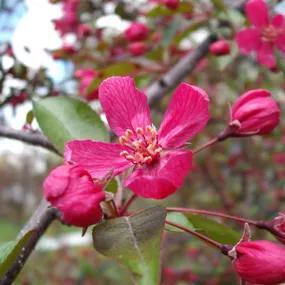Profusion Crab Apple, Large Trees

The details
Delivered in Large Sizes
- American. Masses of red flowers, blood red fruit. Copper young leaves.
- Persistent fruit
- Max. Height: 8m
- Bareroot Delivery: Nov-Mar.
Recommended extras
Description
Malus Profusion Standard Trees
Profusion crab apple trees long season of interest starts with blazing purple-red spring foliage and shoots that simmer down into a dark, almost metallic purple-green colour as they mature. This darker tone provides a background for the deep pink flowers that come out in such quantity that this tree could only be called Profusion! The overall effect is something like the colour of a glass of red wine with sunlight shining through it. After the autumn display of coloured foliage, the clusters of tiny maroon fruit become visible, which can hang on the branches well into the new year. These can be cooked and eaten but apart from being used in crab apple jelly, they are too small to recommend for this purpose. If it has a weakness, it is slightly susceptible to apple canker and mildew, which can be a problem in warmer, damper parts of the country like Wales and South West England, but they are such a magnificent sight that the risk is worth the reward. Profusion forms a medium sized trees with a rounded canopy that tends to droop with age rather than spread outwards so very suitable for the average garden. Ultimately, Profusion will grow to about 8 metres tall.
Have a look at our other varieties of flowering crab apples. For a slightly less gorgeous but more disease resistant variety of red leaved crabapple, have a look at its parent, Malus moerlandsii.
How Standard Trees are Measured:
All the plants in the ornamental trees section are graded as standardss, which means that they are measured by their girth in centimetres 1 metre above ground level (basically, their trunk's waist measurement). They aren't measured by their height, which will vary. So, a 6/8 standard has a trunk with a circumference of 6-8 centimetres and an 8/10 standard has a trunk 8-10 centimetres around.
Planting Instructions
Notes on planting Malus Profusion:
Crabapples are tough plants that thrive in any moderately fertile soil. They tolerate shade well, although we recommend planting them in full sun to get the best display of flowers and fruit. Although a moist, well drained site is ideal, crabapples like heavy clay and don't mind a bit of waterlogging in winter.
They won't grow in deep shade and may struggle in very poor, dry soil.
Prepare your site before planting:
It is good to dig over the site where you plant a tree several months in advance. Kill the weeds first: for tough weeds like nettles, brambles and ground elder, you will usually need a weed-killer to get rid of them. When you dig the soil over, remove stones and other rubbish and mix in well rotted compost or manure down to the depth of about 2 spades.
Watch our video on how to plant a tree for full instructions.
Remember to water establishing trees during dry weather for at least a year after planting.
Tree Planting accessories:
Prepare your site for planting by killing the weeds and grass.
You can buy a tree planting pack with a wooden stake & rubber tie to support the tree and a mulch mat with pegs to protect the soil around the base of your tree from weeds and drying out.
We suggest that you use mycorrhizal "friendly fungi" on the roots of all newly planted large trees: if your soil quality is poor, we strongly recommend it.
You can also improve your soil with bonemeal organic fertiliser.
After you plant a tree, the most important thing to do is water it in dry weather. You will also need to weed around the plants. Watering should be thorough, so the ground is soaked. Let the soil almost dry out before watering again. Watering & weeding will be necessary for at least a year after planting.
If your trees do need pruning, it is ideal to do this in winter. Always hire a tree surgeon to remove large branches.
Special notes on caring for your trees:
Malus Profusion is an ornamental tree that will perform best when it receives a yearly mulch of well-rotted manure or compost to help keep the soil around it fertile.
Remember to check the stake and tie supporting your trees a few times a year. Tighten the tie if it becomes loose and loosen it as the tree grows. Make sure that the tree's trunk isn't rubbing against the stake.
Hygiene & Diseases:
Dead, damaged or diseased wood can be pruned off as soon as it appears.
Disinfect your pruning tools between every cut if there is any sign of disease.
Burn or dispose of any diseased material, do not compost it.
Did You Know?
This hybrid tree comes from the USA, where it was bred in the 1930's.


